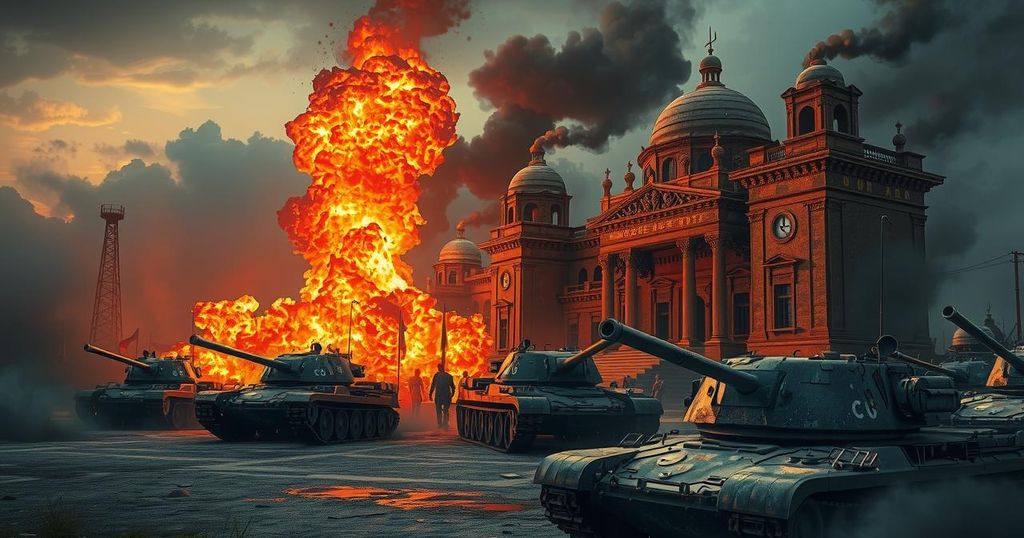As Trump Considers Regime Change in Iran, Past U.S. Actions Serve as a Warning
President Trump contemplates regime change in Iran, recalling past U.S. interventions that illustrate potential pitfalls. Despite Trump’s claims, historical precedents warn of chaos and prolonged instability resulting from military actions. The White House suggests a focus on Iranian internal uprisings rather than direct intervention, though skepticism remains about the effectiveness of exiled opposition figures and the risks of further military engagement in a complex region.
As President Donald Trump raises the prospect of regime change in Iran, historical U.S. interventions in the Middle East provide cautionary tales about the implications of deepening involvement in this region’s conflicts. Recently, Trump took to social media, questioning, “If the current Iranian Regime is unable to MAKE IRAN GREAT AGAIN, why wouldn’t there be a Regime change???” This statement follows military actions by the United States targeting Iranian nuclear facilities, after which Iran retaliated by attacking a U.S. military base in Qatar.
White House press secretary Karoline Leavitt defended Trump, asserting he has not altered his stance on foreign military interventions. “The president’s posture and our military posture has not changed,” said Leavitt, indicating that if Iran persists with its nuclear ambitions, the U.S. might need a more aggressive strategy. She also suggested that regime change might not require direct intervention, hinting at a potential uprising from the Iranian populace.
Such pathways echo strategies taken by previous administrations, a dramatic shift from Trump’s previous dismissals of “endless wars.” U.S.-led regime changes in the past, notably in Afghanistan and Iraq, have not unfolded as smoothly as initially anticipated, often resulting in prolonged instability and chaos in the region.
A key takeaway from history is that early victories can swiftly lead to defeat in both military and political objectives. For example, after the 2001 invasion, the Taliban was ousted within months, but a vigorous insurgency lasted two decades until their return to power following the U.S. withdrawal in 2021. Similarly, in Iraq, the toppling of Saddam Hussein led to civil strife and a fragmented political landscape that persists today.
While Trump asserts that U.S. strikes have weakened Iran’s military capabilities, the significance of ground forces remains. Lessons learned from past military actions, such as the campaign against Libyan leader Moammar Gadhafi, highlight that airstrikes alone do not determine outcomes. Without a ground force capable of engaging the Iranian military, any attempt at regime change could falter.
Moreover, the fragmentation of Iran’s security forces could inadvertently foster civil disorder, yet direct foreign intervention could exacerbate nationalistic sentiments, as evidenced by the historical rallying of Iranians during the 1980 Iraq invasion. Observers note that the current climate appears quiet, with some citizens leaving the capital rather than openly demonstrating.
The role of exiled opposition figures is also a concern. Many who supported the U.S. invasion of Iraq were out of touch with the political realities inside the country. Today’s Iranian opposition groups are similarly divided, lacking a cohesive approach, and their support within Iran is ambiguous. Reza Pahlavi, son of the last Shah, has emerged as a symbolic figure, but memories of his father’s regime complicate his potential appeal.
Lastly, the risk of chaos following regime change is significant. History shows that upheavals in countries like Afghanistan, Iraq, and Libya have led to the emergence of armed factions with varying agendas, foreign interventions, and escalated violence. In many cases, the result was a power vacuum filled by extremists rather than a stable government. Iraq, for instance, saw the rise of a government that, while initially viewed favorably, ultimately became as problematic for U.S. interests as the regime it replaced. Trump’s vision of swift regime change in Iran could easily lead to unanticipated consequences and long-lasting instability.
In summary, President Trump’s recent advocacy for regime change in Iran raises significant concerns reminiscent of past U.S. military interventions in the Middle East. Historical attempts at reshaping governments often led to unforeseen chaos and instability, challenging the notion that regime change guarantees a favorable outcome. As the situation evolves, the lessons learned from conflicts in Afghanistan, Iraq, and Libya underscore the complexity and potential dangers involved in foreign interventions, particularly in a nation as intricately layered as Iran.
Original Source: apnews.com




Post Comment